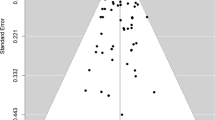Abstract
This paper presents an alternative structure of demand theory based on a marginal rate of substitution (MRS) function. The theory's new results include: 1) criteria are derived for goods to be normal/inferior, "ordinary"/Giffen, and substitutes/complements, for the n-goods case; 2) the total effect of a price change is decomposed into MRS and relative price (RP) effects, corresponding respectively to income and substitution effects for an own-price change but not for a cross-price change; 3) the RP effect of a cross-price increase is always positive; and 4) a good is a complement if and only if the MRS effect is negative and its absolute value is larger than the RP effect. Pedagogically, the new approach makes it possible to teach demand theory speedily and effectively because the MRS is a relatively concrete entity, the theory and its results are transparent, and the results of standard utility-based theory are derived far more easily.
Similar content being viewed by others
References
Allen, R. G. D.Mathematical Analysis for Economists, New York, NY: St. Martin's, 1938.
__. "Professor Slutsky's Theory of Consumers' Choice,"Review of Economic Studies, III, February 1936, pp. 120–9.
Brown, B. J. "Changes in Demand: The MRS and RP Effects," Pace University Economics Working Paper, 1998.
Hicks, J. R.Value and Capital, London, United Kingdom: Oxford University Press, 1939.
Hicks, J. R.; Allen, R. G. D. "A Reconsideration of the Theory of Value," (Part I),Economica, N.S., I, 1, February 1934a, pp. 52–76.
__. "A Reconsideration of the Theory of Value," (Part II),Economica, N.S., I, 2, May 1934b, pp. 196–219.
Johnson, W. E. "The Pure Theory of Utility Curves,"The Economic Journal, 23, December 1913, pp. 483–513, reprinted in W. J. Baumol; S. M. Goldfeld, eds.,Precursors in Mathematical Economics: An Anthology, London, United Kingdom: London School of Economics and Political Science, 1968.
Slutsky, E. "Sulla teoria del bilancio del consummatore,"Giornale degli Economisti e rivista di Statistica, 51, 1915, pp. 1–26, translated in G. Stigler; K. Boulding, eds.,Readings in Price Theory, Homewood, IL: Irwin, 1952.
Vandermeulen, D. C. "Upward Sloping Demand Curves Without the Giffen Paradox,"American Economic Review, 62, June 1972, pp. 453–8.
Wold, H. "A Synthesis of Pure Demand Analysis, I,"Scandinavisk Aktuarietidskrift, 26, 1943, pp. 85–118.
Author information
Authors and Affiliations
Additional information
An earlier version of this paper was incorrectly printed in the May 1999 issue ofIAER.
Rights and permissions
About this article
Cite this article
Brown, B. Consumer theory based on the marginal rate of substitution function. International Advances in Economic Research 6, 336–353 (2000). https://doi.org/10.1007/BF02296113
Issue Date:
DOI: https://doi.org/10.1007/BF02296113




